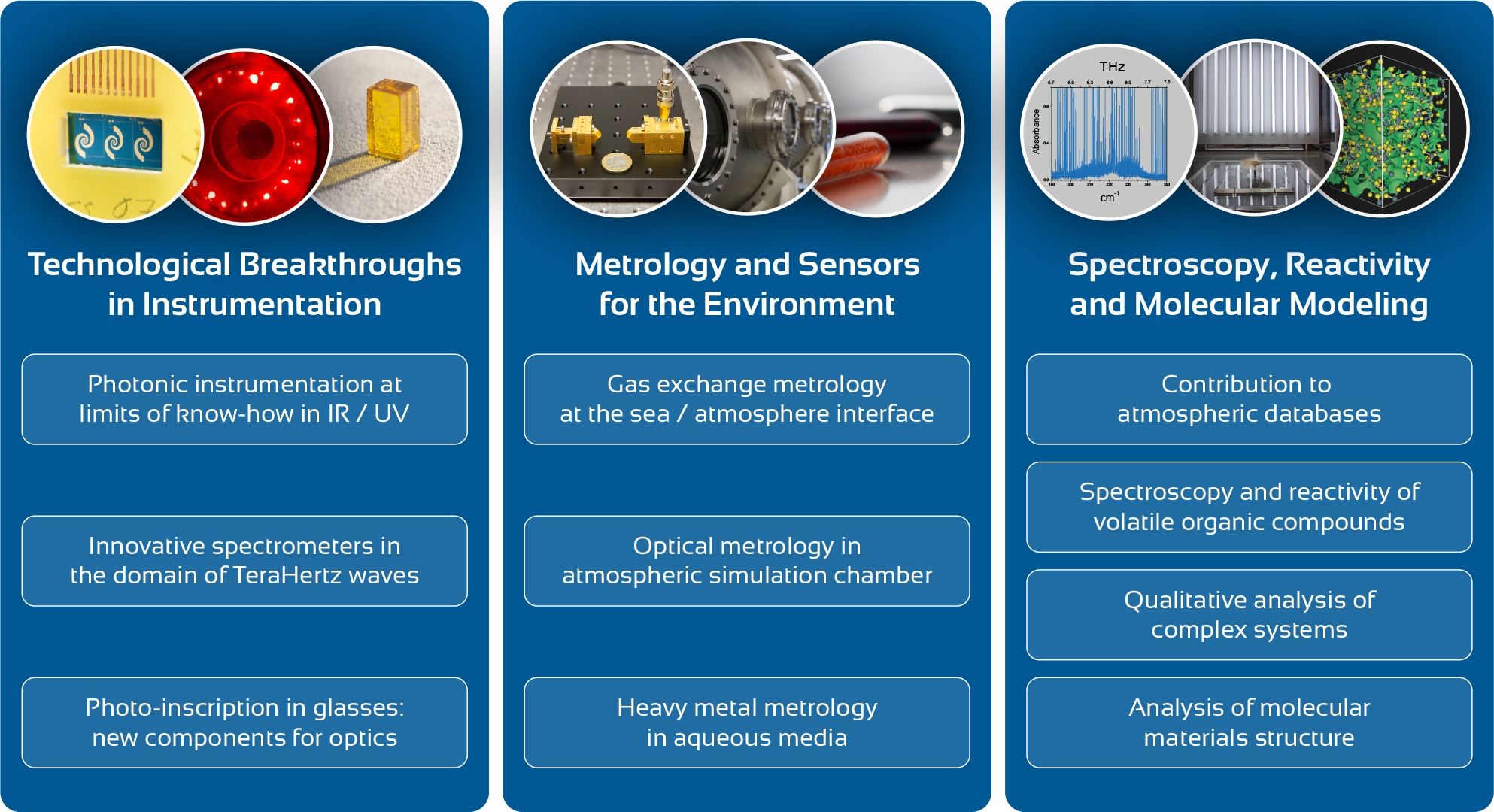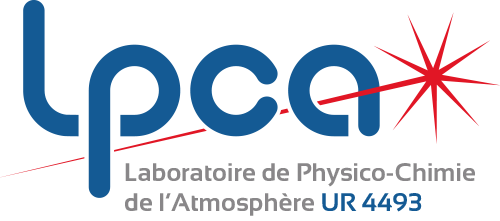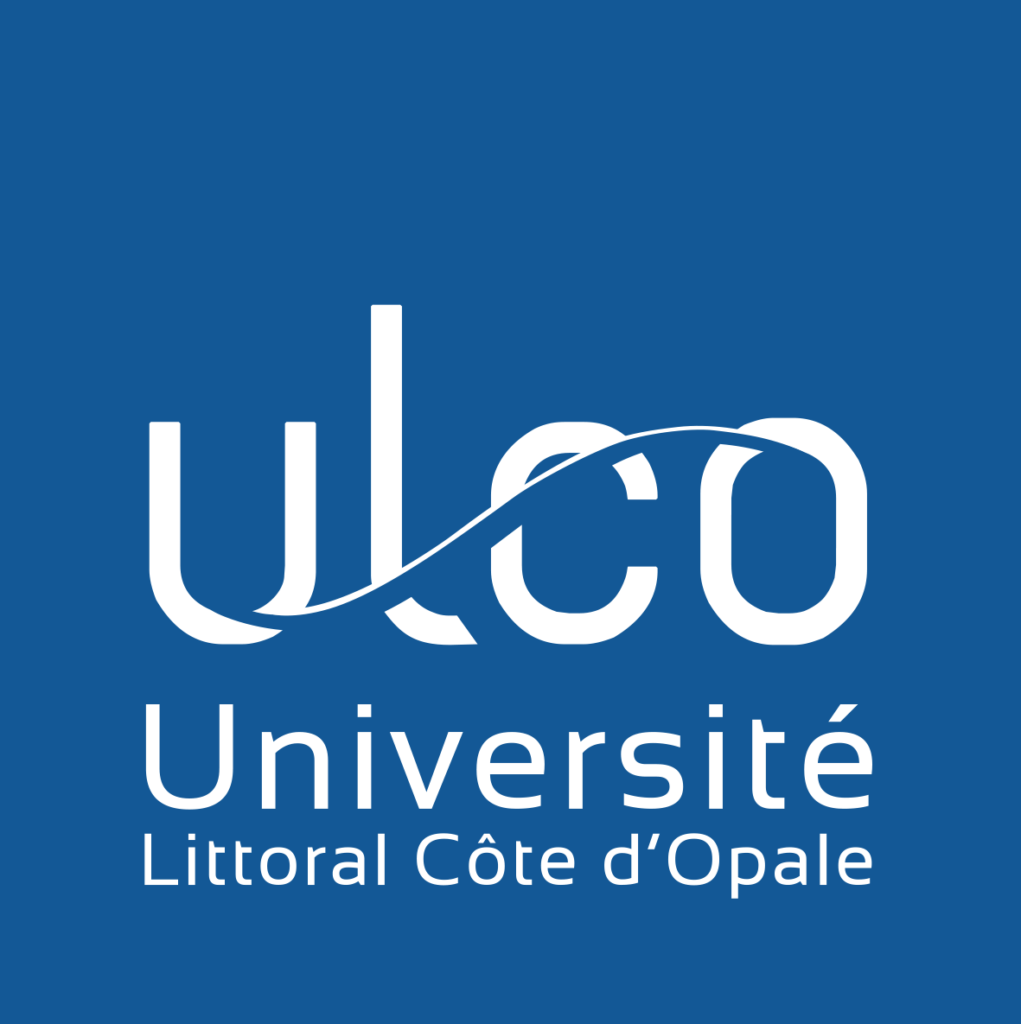
Molecular Physico-Chemistry and Instrumentation
RESEARCH ACTIVITIES
The Molecular Physico-Chemistry and Instrumentation (PCMI) theme offers innovative analyzes, methodologies, technologies and formalisms for the study of the physico-chemistry of the atmosphere through, mainly, the understanding of molecular species of atmospheric interest. Part of his studies focuses on the production of functional molecular materials that can be used in environmental applications.
PCMI offers technological breakthroughs in terms of instrumentation, innovative modeling tools and a field of study in metrology, reactivity and environmental spectroscopy balanced between fundamental molecular physico-chemistry and applications.

PCMI researchers / experimenters are proposing new technological breakthroughs for spectroscopy and environmental metrology:
In the field of terahertz (THz) waves, they take advantage of the latest advances in optics, optoelectronics and electronics, as well as their expertise in the manipulation and exploitation of frequency combs, to propose new approaches that will surpass the capabilities of current THz spectrometers in terms of spectral coverage and frequency metrology. To boost the sensitivity of their instrumentation, they are working on the development of next-generation radio-acoustic detection based on microelectromechanical systems and adapting intra-cavity IR techniques to THz.
In the IR and UV fields, they are developing photonic instrumentation at the limits of know-how for optical metrology of stable and unstable molecules of atmospheric interest. Real progress has been made on measurements in terms of sensitivity and precision, spatial and temporal scales, as well as data acquisition and processing. PCMI is now adapting its instrumentation to field measurements. Today it involves: (i) Telemetry of vertical greenhouse gas concentration profiles using laser heterodyne radiometry; (ii) measurement of atmospheric OH radicals at ultra-low concentration levels by coupling Faraday rotational spectroscopy with the CRDS technique; (iii) high resolution remote sensing by combing greenhouse gas frequencies.
Finally, they use the photo-inscription technique in chalcogenide glasses to produce waveguides in the IR medium, with the aim of optimizing linear guides and studying more complex structures. These are the basic elements of optical circuitry such as curved guides, beam splitters / combiners, or even interferometers. Photo-inscription in chalcogenide fibers is now being considered to design more advanced instruments and integrate them into devices developed by PCMI for the detection of molecular species or aerosols.

In order for our research to better respond to the socio-economic challenges of our territory, part of PCMI’s research is focused on atmospheric physico-chemistry in the marine environment. This will involve, on the one hand, studying the impact of reactive maritime species on the atmospheric oxidation capacity and, on the other hand, studying the exchanges between ocean and atmosphere:
- Instrumentation dedicated to the metrology of halogenated and organosulfur species emitted by the ocean, as well as marine aerosols, is under development. The measurements will be carried out, first, in an atmospheric simulation chamber at the LPCA, before being undertaken in the field through measurement campaigns involving other national and international laboratories;
- In collaboration with the Port of Dunkirk, a panel of photonic instruments capable of performing measurements on the ocean surface but also at depth or even equipping drones will soon be developed.
- THz metrology is used as part of a large European project to qualify the state of freshness of fishery products by offering multi-species quantitative monitoring with a revolutionary detector that can slip into packaging.
PCMI’s metrology / sensor activity also extends to the chemical detection of heavy metal ions in aqueous media. This involves developing new types of sensors through a complete cycle of research from the synthesis of new chalcogenide glasses to the characterization of the performance of the sensors produced without forgetting the intermediate stages of analysis of macroscopic and transport properties. and the structural characterization of materials using the most advanced experimental and theoretical methods. Work is currently being carried out on two new chemical sensors for the detection of mercury and thallium. Subsequently, these chemical sensors will be used for environmental monitoring and industrial process control.

Within PCMI are engaged, on a wide variety of molecules of environmental interest, rovibration spectroscopy studies (analyzes in frequencies, intensities and line profiles) from microwaves to infrared using a THz spectroscopy instrument park. combining electronic and opto-electronic sources but also optical sources via experiments carried out at the SOLEIL synchrotron. Part of these studies is dedicated to supplying international databases (HITRAN, JPL, etc.) through unprecedented measurements of molecular parameters: (i) frequencies of rotational transitions of greenhouse gases; (ii) coefficients of broadening with sophisticated line profiles; (ii) cross sections of semi-volatile organic compounds.
Research developed in PCMI also concerns the study in a simulation chamber of the tropospheric reactivity of Volatile Organic Compounds (VOCs) with the main oxidants (ozone O3, hydroxyl radicals OH and nitrates NO3). This work leads to the determination of rate constants and the characterization / quantification of gaseous and particulate oxidation products (formation of Secondary Organic Aerosols, AOS). All of this data can be used by predictive models of air quality and climate.
PCMI researchers are also working on the use of theoretical tools for the analysis of complex molecular systems due to their symmetry properties, their conformational landscape or their large amplitude movements. They use ab initio quantum chemistry methods to determine the most reliable molecular parameters possible necessary for the prediction and attribution of experimental spectra and develop innovative analysis tools to facilitate or even automate their attribution (eg: evolutionary algorithms, spectral taxonomy…). Ab initio calculations are also used to estimate the rate constants of atmospheric reactions and to study reaction mechanisms. They are also working on the application of topological invariants to molecular physics, on the consequences of certain symmetry operations or on the classical / quantum analysis of specific rotational dynamics.
Finally, a final section of molecular modeling research concerns the study of the structure of disordered or vitreous materials. The deep expertise in the use of large instruments (synchrotrons, neutron sources, etc.) enables PCMI researchers to obtain structural information at the most advanced level today. The complete analysis of this information is impossible without a heavy work of modeling combining empirical and ab initio methods which must be able to establish and predict the structure at the local and intermediate scale as well as the dynamic, vibrational and electronic properties.

STAFF
THESIS IN PROGRESS
-
SAXENA Aditya 2024-2027
"Titre" [W. CHEN (LPCA)]
-
SOLAIMAN Sandy 2023-2026
"Devenir atmosphérique des produits d'oxydation de première génération des monoterpènes : implication sur le budget des photo-oxydants et des propriétés des aérosols" [C. COEUR (LPCA), E. ROMANIAS (IMT Nord)]
-
SIMON Fabien 2023-2026
"Réduction des émissions polluantes par procédé plasma" [G. MOURET (LPCA), F. HINDLE (LPCA)]
-
HU Yongyong 2023-2026
"Développement de nouvelle génération d'instrument embarqué sur drone pour la métrologie optique des polluants dans l'environnement marin" [W. Chen (LPCA), T. NGUYEN BA (LPCA)]
-
SHANG Zhijin 2023-2026
"Etude cinétique des réactions de photolyse de HONO en chambre de simulation CHARME" [W. CHEN (LPCA)]
-
AL MAWLA Reem 2022-2025
"Impacts sur la qualité de l'air et la santé de nouveaux biocarburants utilisés pour le transport terrestre" [C. COEUR (LPCA), S.BILLET (ULCO)]
-
BRACQUART Colwyn 2022-2025
"Les aérosols organiques secondaires: micro-solvatation, hygroscopicité et réactivité atmosphérique des précurseurs" [A. CUISSET (LPCA), E. GOUBET (U. Lille)]
-
KHABBAZ Alexandra 2021-2024
"Peigne de fréquence et spectroscopie THz" [G. MOURET (LPCA) / JF. LAMPIN (CNRS -IEMN)]
PUBLICATIONS


